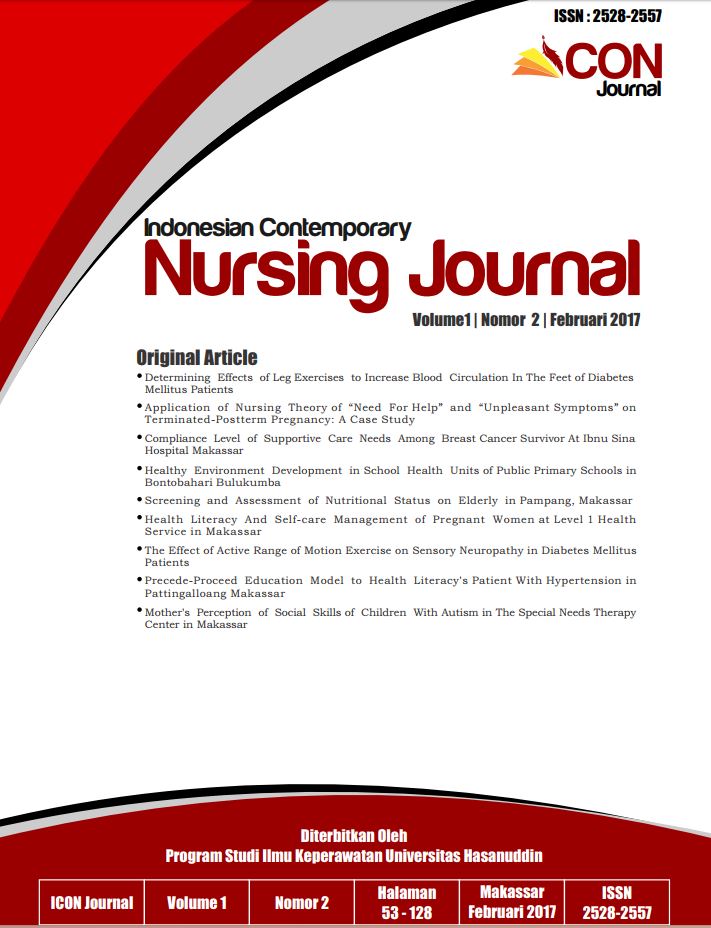Application of Nursing Theory of “Need For Help” and “Unpleasant Symptoms” on Terminated-Postterm Pregnancy: A Case Study
DOI:
https://doi.org/10.20956/icon.v1i2.3445Abstract
Introduction: Post-term pregnancy is a prolonged pregnancy period till 42 weeks or more that can be caused by varied factors such as hormonal and genetic. Although the incident rate is considerably small, it can bring negative impacts to mother and her baby. Thus, it is important to manage the post-term pregnancy by applying effective approaches such as Need for help Nursing Theory to ensure rapid and precise assessment, observation and immediate intervention carried out during delivery process. In addition, The Theory of Unpleasant symptoms can also be applied to minimize unpleasant symptoms either physically or psychologically and situational discomfort during the labor. Method: The five study cases revealed that the mothers experienced unpleasant symptoms that affected each other and required immediate treatment. Result: After termination with labor induction were conducted, different results were found among the cases. Case two to five after be indiuced, they gave birth trough vaginal birth, while case one ended with caesarean section because`of fetal distress. Conclusion: Mothers who experienced postterm pregnancy had different respond. Nurse role especially maternity nursing specialist is imperative during the gravidity termination period in performing nursing care to overcome problems experienced by mother with post-term pregnancy.References
Alligood, M. R., & Tomey, A. M. (2006). Nursing theorists and their work (Sixth ed.). Saint Louis: Mosby.
Caughey, A. B. (2013). Postterm pregnancy. Retrieved from http://emedicine.medscape.com/article/261369-overview#a1
Caughey, A. B., Stotland, N. E., Washington, A. E., & Escobar, G. J. (2009). Who is at risk for prolonged and postterm pregnancy? American Journal of Obstetrics and Gynecology, 200(6), 683.e681-683.e685. doi: 10.1016/j.ajog.2009.02.034.
Gilbert, E. S., & Harmon, J. S. (2003). Manual high risk pregnancy and delivery (Third ed.). Saint Louis: Mosby.
Kementerian Kesehatan RI. (2010). Riset Kesehatan Dasar (Riskesdas 2010) Retrieved from http://dinkes.ntbprov.go.id/sistem/data-dinkes/uploads/2013/10/Laporan_riskesdas_2010.pdf
Kistka, Z. A. F., Palomar, L., Boslaugh, S. E., DeBaun, M. R., DeFranco, E. A., & Muglia, L. J. (2007). Risk for postterm delivery after previous postterm delivery. American Journal of Obstetrics and Gynecology, 196(3), 241.e241-241.e246. doi: 10.1016/j.ajog.2006.10.873.
Laursen, M., Laursen, C., Bille, A., Olesen, J., Hjelmborg, A., Skytthe, K., & Christensen. (2004). Genetic influence on prolonged gestation: A population-based Danish twin study. American Journal of Obstetrics and Gynecology, 190(2), 489-494. doi: 10.1016/j.ajog.2003.08.036
Mandruzzato, G., Alfirevic, Z., Chervenak, F., Gruenebaum, A., Heimstad, R., Heinonen, S., . . . Thilaganathan, B. (2010). Guidelines for the management of postterm pregnancy. J. Perinat. Med, 38, 111–119. doi: 10.1515/JPM.2010.057.
Norwitz, E., Snegovskikh, V., & Caughey, A. (2007). Prolonged pregnancy: When should we intervene? Clinical Obstetrics and Gynecology, 50(2), 547-557.
Olesen, A. W., Westergaard, J. G., & Olsen, J. (2006). Prenatal risk indicators of a prolonged pregnancy. The Danish Birth Cohort 1998–2001. Acta Obstetricia et Gynecologica Scandinavica, 85(11), 1338-1341. doi: 10.1080/00016340600935508.
Parker, M. E. (2001). Nursing theories and nursing practice. Philadelphia: F.A Davis Company.
Perry, S. E., Hockenberry, M. J., Lowdermilk, D. L., & Wilson, D. (2010). Maternal child nursing care (Fourth ed. Vol. 1). Saint Louis: Mosby.
Peterson, S. J., & Bredow, T. S. (2004). Middle range theories application to nursing research. Philadelphia: Lippincott Williams & Wilkins.
Potter, P. A., & Perry, A. G. ( 2004). Foundamental of Nursing (6 th ed.). Saint Louis: Mosby.
Reeder, S. J., Martin, L. L., & Koniak-Griffin, D. (2011). Keperawatan maternitas kesehatan wanita, bayi dan keluarga (Maternity nursing: Family, newborn, and women's health care) (Y. Afiyanti, I. N. Rachmawati, A. Lusyana, S. Kurnianingsih, N. B. Subekti & D. Yulianti, Trans. 18 ed. Vol. 2). Jakarta: EGC. Buku Asli diterbitkan tahun 1997.
Ricci, S. S. (2009). Essential of maternity, newborn, and women's health nursing (Second ed.). Philadelphia, PA: Wolters Kluwer Lippincott Williams and Wilkins.
Roos, N., Sahlin, L., Ekman Ordeberg, G., Kieler, H., & Stephansson, O. (2010). Maternal risk factors for postterm pregnancy and cesarean delivery following labor induction. Acta Obstetricia et Gynecologica Scandinavica, 89(8), 1003-1010. doi: 10.3109/00016349.2010.500009.
Savitz, D. A., Terry Jr, J. W., Dole, N., Thorp Jr, J. M., Siega-Riz, A. M., & Herring, A. H. (2002). Comparison of pregnancy dating by last menstrual period, ultrasound scanning, and their combination. American Journal of Obstetrics and Gynecology, 187(6), 1660-1666. doi: 10.1067/mob.2002.12760.
Smith, M. J., & Liehr, P. R. (2008). Middle range theory for nursing (Second ed.). New York: Spinger Publishing Company.
Susan, L. W., & Shelton, M. H. (2011). Maternal child nursing care: Optimizing outcomes for mothers, children and families. Philadelphia: F.A Davis Company.
Taipale, P., & Hiilesmaa, V. (2001). Predicting delivery date by ultrasound and last menstrual period in early gestation. Obstetrics and Gynecology, 97(2), 189.
Torricelli, M., Ignacchiti, E., Giovannelli, A., Merola, A., Scarpetti, E., Calonaci, G., . . . Petraglia, F. (2006). Maternal plasma corticotrophin-releasing factor and urocortin levels in post-term pregnancies. European Journal of Endocrinology, 154(2), 281-285. doi: 10.1530/eje.1.02091.
Zeitlin, J., Blondel, B., Alexander, S., & Bréart, G. (2007). Variation in rates of postterm birth in Europe: Reality or artefact? BJOG: An International Journal of Obstetrics and Gynaecology, 114(9), 1097-1103. doi: 10.1111/j.1471-0528.2007.01328.x.
Downloads
Published
How to Cite
Issue
Section
License
Authors who publish with this journal agree to the following terms:Authors retain copyright and grant the journal right of first publication with the work simultaneously licensed under a Creative Commons Attribution License that allows others to share the work with an acknowledgement of the work's authorship and initial publication in this journal.
Authors are able to enter into separate, additional contractual arrangements for the non-exclusive distribution of the journal's published version of the work (e.g., post it to an institutional repository or publish it in a book), with an acknowledgement of its initial publication in this journal.
Authors are permitted and encouraged to post their work online (e.g., in institutional repositories or on their website) prior to and during the submission process, as it can lead to productive exchanges, as well as earlier and greater citation of published work (See The Effect of Open Access).



